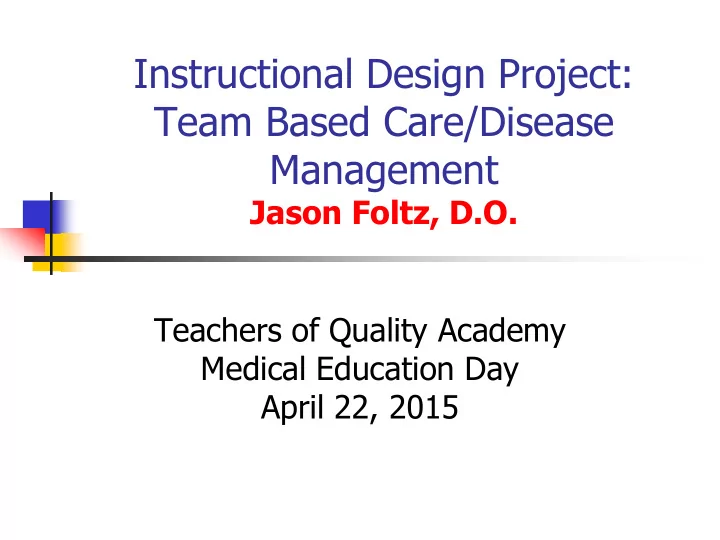

Instructional Design Project: Team Based Care/Disease Management Jason Foltz, D.O. Teachers of Quality Academy Medical Education Day April 22, 2015
Proposed Assessment Introduction to Team Based Care and Disease Management to Improve Health Outcomes of a Population of Patients Assigned to the Family Medicine Center
Rationale/Need Team based care, Disease Management, and Population Health are relatively new concepts in medicine Currently, no known formal process exists to teach these concepts in medical student education Proposed population: M3 students on Family Medicine Clerkship
Collaborative Team Members Jason Foltz, TQA Fellow Susan Schmidt, Director of MSE FM Susan Keen, M3 Clerkship Director Tammy Mckinney, Clerkship Coordinator Team Leader Key Contact Info: Jason Foltz, foltzj@ecu.edu, 744-4615
Goals Understand the key healthcare tenets driving change within our healthcare system Value the role of other healthcare professions within a team to coordinate care Define a patient centered medical home and its role in management of a population of patients Use health information technology to track high risk patients to manage a disease process
Objectives Integrate into a health care team to understand the value of each member of the team Access the ECU Physicians Electronic Health Record and run a report on a specific disease metric Collaborate with module leaders on a strategy to intervene on 3 patients with a chronic disease Implement a plan and act to coordinate care plans on 3 selected patients
Instructional Techniques Flipped classroom (online learning modules) Lecture Demonstration by teacher Small Group work
Implementation 3 phases of learning: Orientation: lecture block on key 1. components of goals Time between orientation and 2 2. week ambulatory rotation: independent work with online IHI modules 2 week local ambulatory 3. experience: identify 3 high risk patients, coordinate with care team on plan, identify strategy to intervene with patient
Implementation Option to intervene on: A health maintenance topic Uncontrolled diabetic Uncontrolled hypertensive Uncontrolled asthmatic Intervention ideas: Calling patient and scheduling a follow up during their time on rotation Calling and giving health coaching advice Developing a mass mailing Coordinating care with one of other integrated care team member
Example Dashboard
Assessment Log of patients identified with intervention and outcome Patient Disease Metric Intervention Outcome Participation points assigned for IHI module and patient log Educational activity assessed by student end of clerkship evaluation
Validity Area of Validity Strengths Weaknesses Future Evidence to Gain Content -Based on the learning - Students that do not - Does participation in a objectives, the outcome have an interest may hands on learning measurement of the simply complete the activity directly related patient logs adequately log without putting to team-based care and measures that the student forth much effort in patient orientated achieved the objectives attempting to make a outcomes encourage laid out within the activity change in that specific students to look - Students will be patient. favorably toward the required to take a -In order to make room in specialty of Family proactive role to the clerkship curriculum, Medicine? identify a patient group other content areas may of interest and need to be shortened or formulate a plan to discontinued inflict change. This will require the student to identify their own learning goals.
Relevance Aligns with the educational goals for: The Brody School of Medicine Society for Teachers of Family Medicine Clinical Prevention and Population Health Curriculum Framework
Challenges Encountered Designing alternative plan for students assigned to non ECU clinics Faculty and staff development on use of disease dashboards, population health Limitations in ability to start care coordination program within clinic Timing to initiate prior to July 2015 new clerkship
Lessons Learned Value of running details by educational team Allowed for further details to be vetted Learned the components required to formulate an educational design project
Next Steps Integrate care coordinator within FMC Further work with faculty on use of clinical dashboards Identify best time to pilot curriculum change within upcoming M3 clerkship
Conclusion Teaching tenets of population health helps prepare the next generation of physicians to work toward improving outcomes related to the “triple aim” 8 Dimensions of care: Safe, Effective, Patient- Centered, Timely, efficient, and Equitable Quality Affordability
Questions?
Acknowledgements This poster was prepared with financial support from the American Medical Association (AMA) as part of the Accelerating Change in Medical Education Initiative. The content reflects the views of the authors and does not necessarily represent the views of the AMA or other participants in this initiative.
Recommend
More recommend